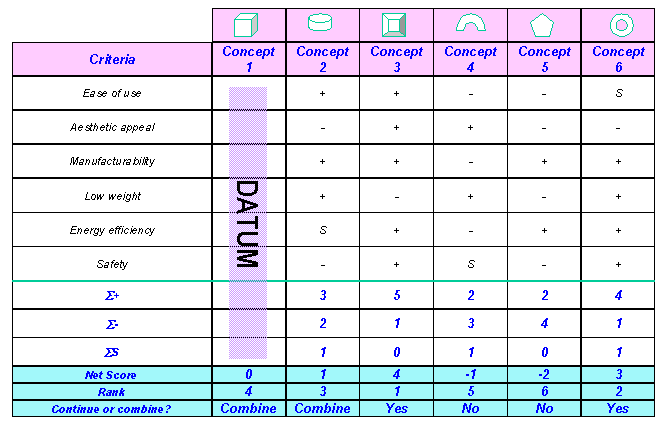Controlled convergence
Developed in the 1980s by Stuart Pugh, 'controlled convergence' uses a simple matrix to compare concepts against a set of pre-determined criteria. Aims to provide structure to the evaluation of alternative or competing concepts and benefits from being both non-numeric and also iterative.
Method
Sketch the concepts
If there are many competing alternatives, then identify the 5-10 front runners. If there are fewer than 5, then it may be wise to use some creative methods to generate more. Each concept should be represented by a simple concept and maybe a few words - but not just words alone. The sketches should be produced to the same level of detail and must communicate the key ideas embodied in each. Finally, give each concept a name.
Prepare the matrix
The most critical aspect of the matrix is the list of selection criteria against which the concepts will be evaluated. These should be driven by a deep understanding of customer needs and reflect the desires and buying motivations of the target audience. Again, if it is difficult to prepare a list, then a greater understanding of customer needs is probably required. Also consider selection criteria which are based upon the needs of internal stakeholders, such as manufacturability, assembly, service, unit cost, technical uncertainty, risk, maintenance, point of sale etc.
The final list of criteria should be unambiguous and must be agreed by the full team. A good target of high level criteria is around 10. The list of criteria is the vertical axis of the matrix and the product concepts form the horizontal axis.
Compare concepts
Choose one of the concepts as a 'datum concept'. It doesn't matter which one, but it can help if it is a product that already exists. In turn, compare each concept with the datum for each of the criteria. If the concept is better or easier, then mark it "+". If it is worse or harder, then mark it "-" finally if it is similar to or the same as the datum, then mark it "S". For each concept, add up the total number of "+", "-" and "S" scores and take the "-" total away from the "+" total. Each concept will now have a score, and it is possible to rank them in preferential order.
Combine and improve
It is possible, that when discussing the merits of each concept, there is a basically good concept, which suffers from one poor feature. In this case, a minor modification could improve the overall solution. There may also be concepts which are not worthy of any further consideration and have no redeeming features. The last stage is to formally record whether any of the concepts will be continued with or combined.
Repeat
Repeat the cycle, taking one of the stronger concepts as a new datum. If possible, increase the level of detail or specificity in the selection criteria and add some quantifiable values. This step is especially important if new concepts have arisen from the first round.
Reflect
The process is only as effective as the team input, the choice of selection criteria and the quality of the basic concepts. It is worthwhile to reflect on the process. Is there team agreement on the outcome? Does one solution clearly stand out above the rest? Do the results make sense and are there any consistently bad features? If there is no outstanding solution, then there may be ambiguous criteria or perhaps the concepts are too similar.

For more information, please contact:
T: +44 1223 764830









